How to adjust the thickness of the bean grinder | what kind of cooking method is suitable for ear powder, hand powder and coarse powder?
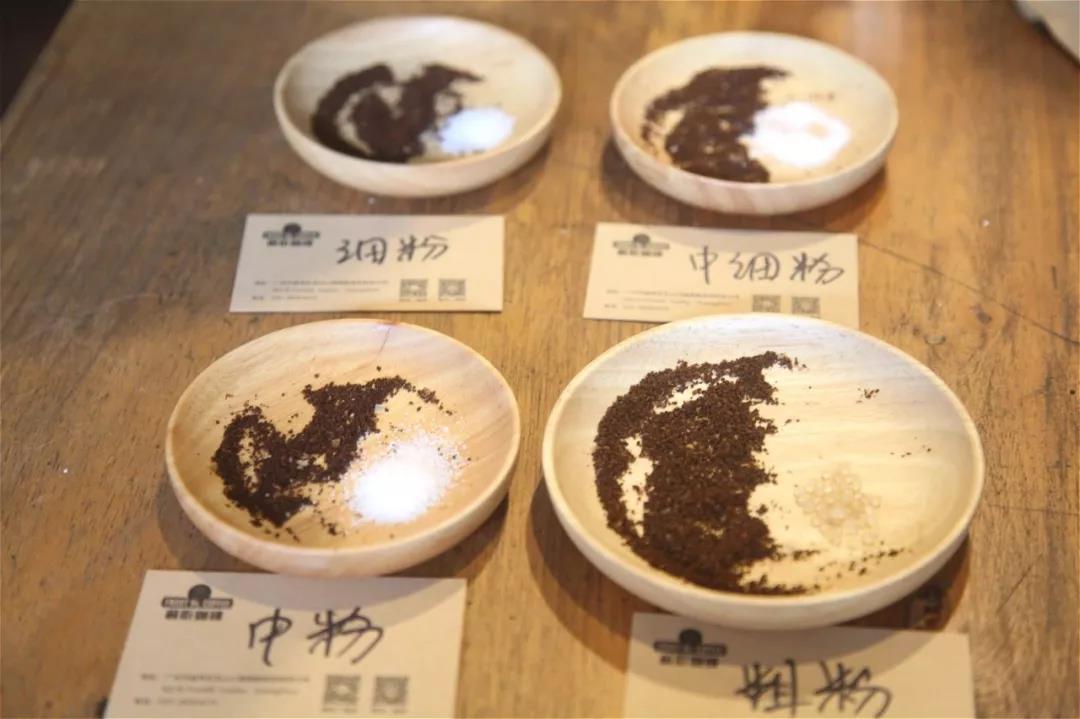
Professional coffee knowledge exchange more coffee bean information please follow the coffee workshop (Wechat official account cafe_style)
How to adjust the thickness of the bean grinder | what kind of cooking method is suitable for ear powder, hand powder and coarse powder?
Coffee grinding is not the finer the better, of course, too much fine powder is not good, because too much fine powder or the grinding degree is too fine can easily lead to blockage of the sewer, resulting in over-extraction. Usually when we finish brewing coffee, if we see a situation like this in the picture below, then there is too much fine powder or too fine grinding.
If the degree of grinding is uneven, we will see two situations:
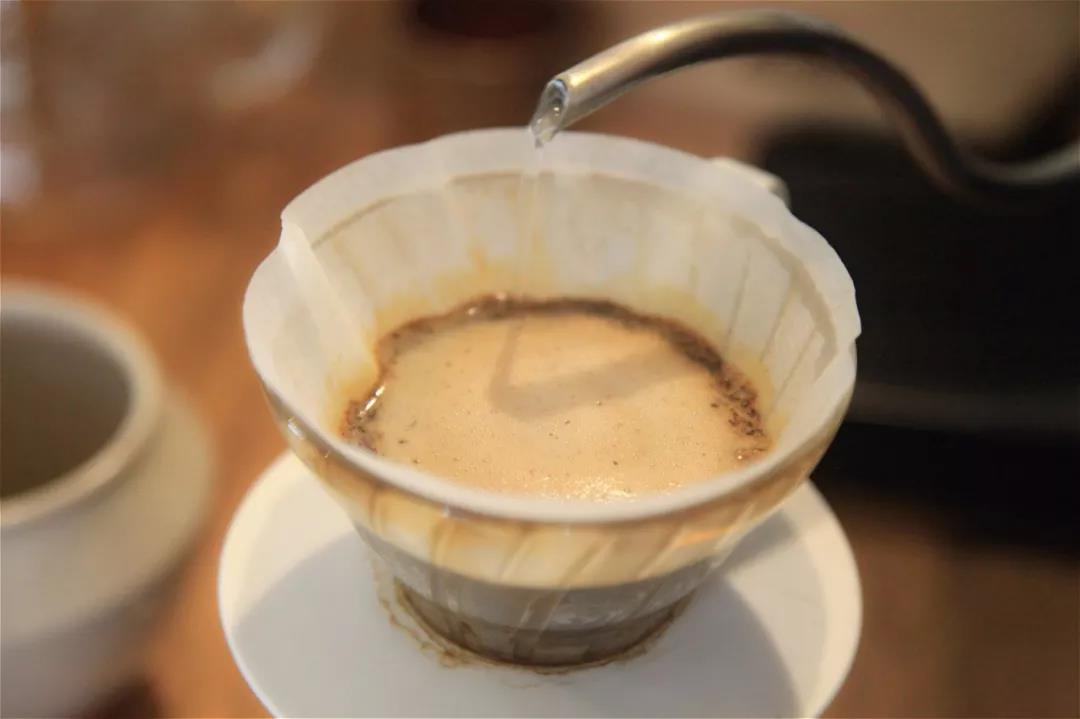
1. The fine powder is laid on the surface of the powder bed. If there are more times of stirring during cooking, or if the current is relatively large, you will find that the fine powder is on the surface of the powder bed, and the powder below is relatively coarse. This is because there is more water supply and the water level is higher, so the fine powder floats up.
2. The coarse powder is laid on the surface of the powder bed. This situation is just the opposite of the above, because the water flow is small, the number of stirring is not much, and the water supply is small, so the water level is not high, and the fine powder does not float up with the water, so the coarse powder will be on the surface.
The thickness of coffee powder is related to the amount and speed of coffee ingredients released when brewing coffee. Generally speaking, the thickness of coffee powder can be divided into five grades: very fine powder, fine powder, medium powder, coarse powder.
(1) very fine powder: suitable for espresso
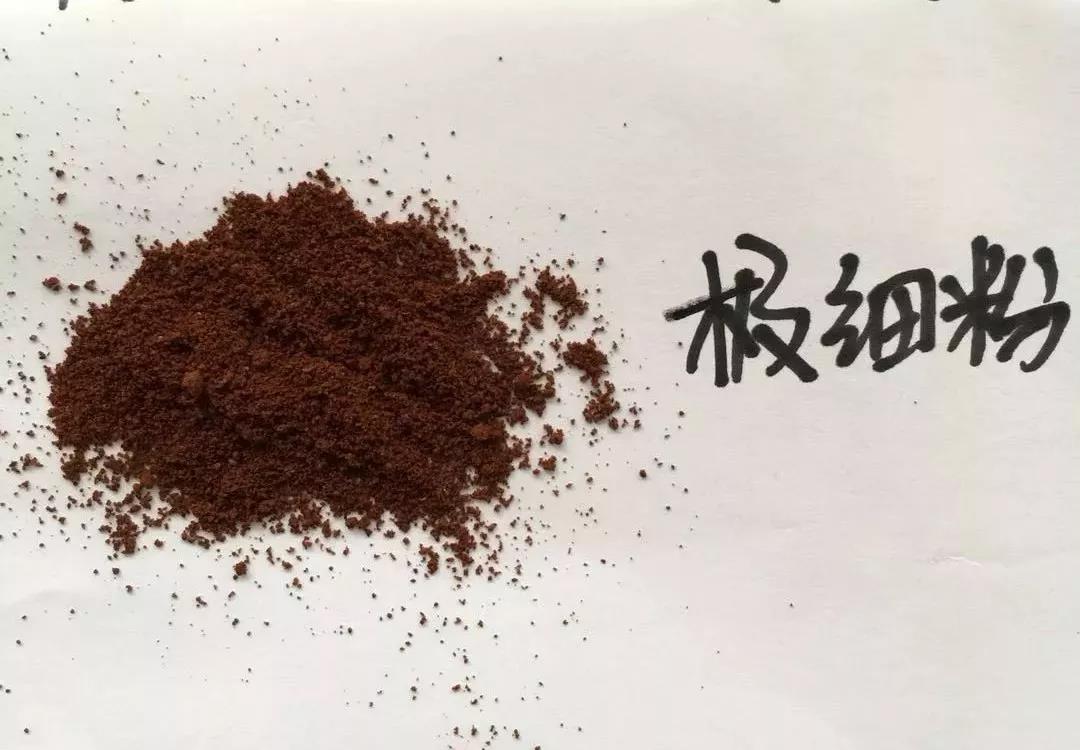
This is the best to understand, and the usage is relatively absolute, only used when making espresso. Because the extraction method is different from the usual principle of brewing at home, it needs to be pressurized, so the appliance is an Italian coffee machine, and the grinding also requires a professional coffee mill to achieve extremely fine.
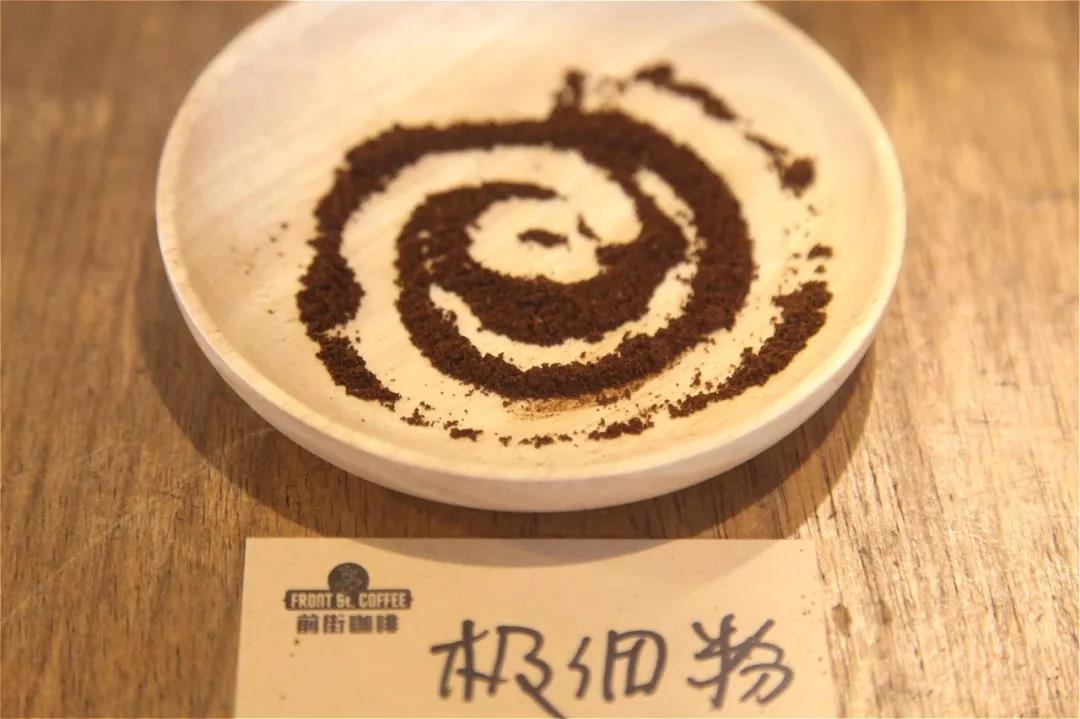
Because when making espresso, we must make efforts to fill the coffee powder to make it resistant to high-pressure hot water, so that we can really extract the essence of coffee. Therefore, it is more sensitive to the degree of grinding, the more uniform grinding, the more compact the coffee powder, and less space, can produce balanced resistance to water, so that a cup of Espresso can be extracted successfully.
If you use a mocha pot to make coffee, it is also more suitable to use very fine powder, but the extraction is generally excessive, although a little oil can come out, but the taste is bitter, and the enjoyment process is often greater than the taste itself. At the same time, we should not blindly pursue grease and grind the beans too fine, otherwise it will plug the exhaust hole and cause danger.
(2) Fine powder: suitable for hanging ears
Fine powder is suitable for hanging-ear coffee. Many people will think that some of the ears should be soaked in water, and thicker particles should be used. In fact, it is mainly because the ears are all filter paper, and the water output is very large. Unlike hand flushing with a closing position, such as the commonly used three-hole filter cup, it actually slows down the speed of water outflow, so hanging ears need fine powder to increase the extraction area and extract more substances.

The fine powder is slightly smaller than the fine granulated sugar (fine granulated sugar or young granulated sugar for baking), and give a reference, salt. Less than sugar, more than salt, that's right.

(3) medium and fine powder, (suitable for light baked beans, small Fuji ghost teeth 3.5)
Medium and fine powder ≈ white granulated sugar (the most common white granulated sugar in the supermarket, a little bigger than that). Generally, the hand will eventually be fixed on the thickness of the medium and fine powder, because the medium and fine powder is very commonly used, so if you love coffee, you should try your own coffee mill and find the most suitable level of medium and fine powder.


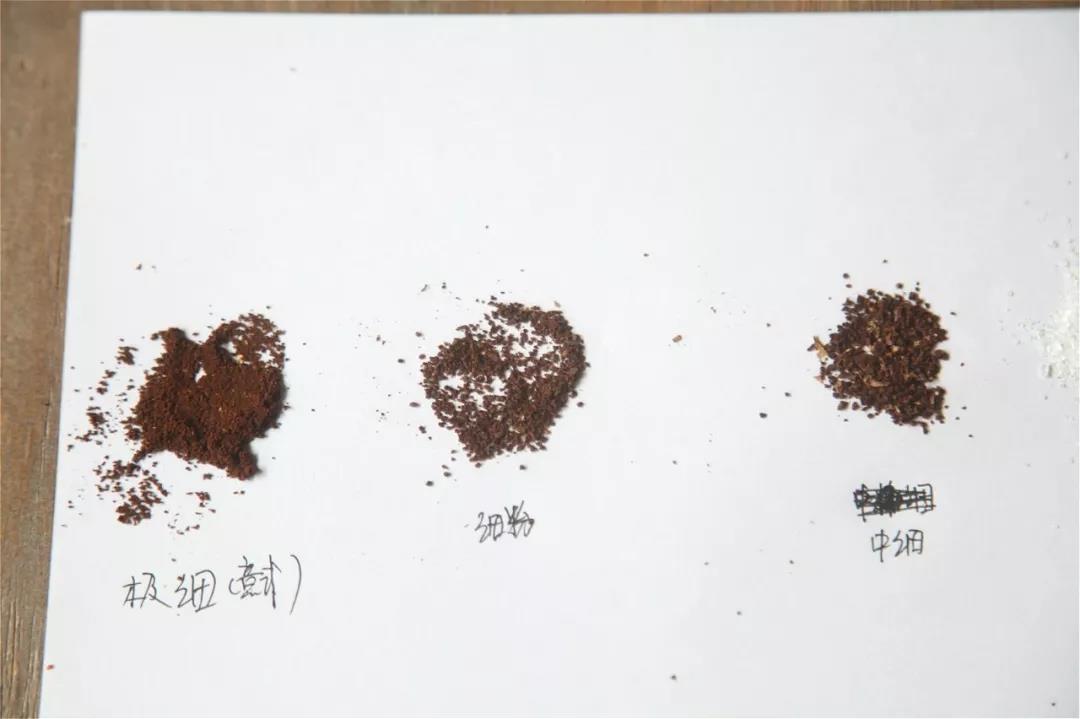
(4) medium flour (suitable for medium-baked beans, small Fuji ghost teeth 4)
Medium powder = granulated sugar (the largest granulated white granulated sugar seen in the supermarket is this kind of thickness most of the time), the medium powder is slightly thicker than the medium fine powder, but not as large as the coarse powder.

It is recommended that beginners first use medium powder for hand flushing. After all, grinding powder is not easy to produce very fine powder, and it is not easy to soak coffee powder in the filter cup due to the accumulation of water in the filter cup at the beginning of the unstable flow control, thus causing coffee extraction to be excessive. In addition, because personal tastes are different, you can try more between medium powder and fine powder to find a suitable thickness.

(5) coarse flour (suitable for medium and deep baked beans, small Fuji ghost teeth 4. 5)
Coarse powder (with coarse white granulated sugar, finer than yellow sugar,), suitable for siphon pot and pressure, coarse powder in high water temperature extraction, it is not easy to extract bitter taste, the same can not be ground too coarse, the taste will be light if the extraction is insufficient.


A more uniform degree of grinding is also important:
Coffee beans become powdered after grinding, and the distribution of powder size has a lot to do with the quality of coffee drinks. If there is too much fine powder of coffee powder and too much contact between water and the surface of coffee powder, the fine powder will give priority to extract too many unnecessary impurities, even bitterness; while the relatively coarse powder particles, the taste is not extracted, where there is no contact with hot water, the brewed coffee does not have enough aroma. Half of the extraction is insufficient, the other is over-extracted, and the taste is certainly not very good.
However, an appropriate amount of uneven grinding will bring a sense of hierarchy, so it is necessary to control the extraction time. When we use the V60 filter cup, the thickness of the powder layer is larger, and the contact time between the powder and water is longer, usually the fine powder is easy to gather at the bottom, and it is easy to extract bitterness from soaking for a long time, so it is necessary to control the amount of fine powder. If the home grinding the same scale of fine powder is too much, you can use a powder sieve to keep the fine powder in a certain range.

The degree of grinding plays an important role in cooking. Beans with different baking degrees and characteristics will choose the corresponding degree of grinding. in most cases, medium-to-light roasted beans (such as rose) can be used in medium and fine. medium-baked beans can be moderately grinded, medium-baked beans can be roughly ground, and different grind degrees can be used to match the baking degree and bean characteristics, in order to reduce the release of bad taste. At the same time, it should also cooperate with the corresponding cooking techniques.

[Tiger Manning as an example]:
[V60 hand flush]

Filter cup: Hario V60
Water temperature: 88 degrees
Degree of grinding: small Fuji grinding degree 4, coarse powder
Cooking methods: the ratio of water to powder is 1:15, 15g powder, the first injection of 25g water, 25 s steaming, the second injection to 120g water cut off, waiting for the powder bed water to half and then water injection, slow water injection until 225g water, extraction time about 2:00
Analysis: using three-stage brewing to clarify the flavor of the front, middle and back of the coffee. Because the V60 has many ribs and the drainage speed is faster, when the water is cut off, it can prolong the extraction time and better extract the nut and chocolate flavor of the tail section.
Flavor: the level is changeable, the whole is clean, the taste is thin, the finish is long-lasting caramel sweet, there will be a hint of bitterness.
[KONO hand flush]

Filter cup: KONO filter cup
Water temperature: 88 degrees
Degree of grinding: small Fuji grinding degree 4, coarse powder
Cooking method: the ratio of water to flour is 1:14, 17g powder, 25g water for the first time, steaming for 30s, and 238g water for the second time. The extraction time is about 2:30 seconds.
Analysis: there are not many ribs at the bottom of the Kono cup, and the filter paper clings to the filter cup to achieve the purpose of limiting air flow, which can make water and coffee powder have longer contact soaking time in the filter cup and ensure the extraction time and extraction rate of rough grinding. In this way, the coffee powder can be fully extracted, enhance the mellow taste and make the taste more concentrated.
Flavor: well balanced, clean, thick and solid on the palate, with a long dark chocolate finish.
[siphon pot]
Appliance: Hario siphon kettle

Water temperature: 89 degrees
Degree of grinding: small Fuji 3.5, medium fine powder
Technique: it is recommended that 20 grams of powder for 2 people, the ratio of water to powder at 1:12, add 240g hot water to the pot, use the method of adding powder, after blistering, measure the temperature at 89 degrees Celsius, stir for 4-5 times, steam for 30 seconds, extract for about 30 seconds, then turn off the fire, finally, stir quickly for 2-3 times, waiting for the coffee liquid to fall freely.
Analysis: siphon pot coffee heated by fire will produce differences in high, medium and low temperature with brewing, thus creating rich flavor changes. At high temperature, the aroma of [Tiger Manning] coffee is very strong, with high-quality herbal aromas. when the temperature drops to 70 degrees, it presents a rich and full taste of nuts, and the sweetness of caramel will gradually emerge.
Flavor: round texture, full-bodied taste, herbs and dark chocolate, accompanied by caramel sweetness.
[Philharmonic pressure cooking]
Utensils: love music pressure
Water temperature: 85 degrees

Degree of grinding: small Fuji 3.5, medium fine powder
Technique: for the preparation of Philharmonic pressure backpressure, it is recommended to add 20 grams of coffee powder, the ratio of water powder to water is 1: 15 and 85 degrees water, first inject 100g, stir three to five times to make the coffee powder fully wet, rest for 30s, add remaining hot water to 300g, rest for 30s, then stir for 5s, wait until 1 minute 50 seconds when inverted, vertical uniform pressure, the total time is about 2:30 seconds.
Analysis: the production material of Philharmonic pressure has the advantages of slow heat dissipation and less loss of temperature. we use 85 degrees of water and appropriate pressure to brew low acidity and no bitterness, clean and smooth taste; complete immersion can maximize and evenly extract, retain the [Tiger Mantenin] flavor intact; pressure extraction in the pressing process can get a thicker alcohol thickness than other soaked coffee. The density of the filter paper is high, and the coffee filtered out is very clean, which enhances the sweetness and smoother texture.
Flavor: full-bodied, refreshing herbal flavor, medium caramel sweetness and nutty chocolate.
[French pressure kettle]

Utensils: French pressure kettle
Water temperature: 88-89 degrees
Degree of grinding: small Fuji grinding degree 4, coarse powder
Technique: 20 g coffee beans, water powder ratio 1: 14. Pour 88 degrees water into the kettle to 280g, start the clock, put the lid on the lid, stop the strainer at the top, wait for two and a half minutes, and then press the strainer to the end.
Analysis: using immersion extraction, the front extraction is faster, the rear extraction is slower; the coffee powder is all soaked in water to evenly extract, so that the [tiger manning] taste is balanced, and it is not easy to produce bitter taste; press the filter powder layer with a metal filter to retain the rich oil, increase the smooth taste, improve the alcohol thickness and caramel sweetness.
Flavor: balanced taste, mellow texture, good fat, with a little sweetness

Important Notice :
前街咖啡 FrontStreet Coffee has moved to new addredd:
FrontStreet Coffee Address: 315,Donghua East Road,GuangZhou
Tel:020 38364473
- Prev
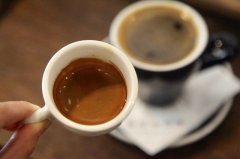
Characteristics of Americano, Long Black and Lungo differentiate American Coffee making process parameters
Professional coffee knowledge exchange more coffee bean information please follow the coffee workshop (Wechat official account cafe_style) the correct way to drink American coffee | what is the difference between black coffee Americano, Long Black and Lungo? American coffee (English: Americano, Italian: Caff Americano) is a black coffee made by using a drip coffee pot, because it is ordinary.
- Next
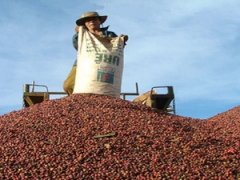
Vietnamese farmers face a very headache: there are no coffee beans in the coffee fruit!
Professional coffee knowledge exchange more coffee bean information Please follow the coffee workshop (Wechat official account cafe_style) Vietnamese farmers are facing a very headache: there are no coffee beans in the coffee fruit. Vietnam is the world's largest producer of robusta coffee, and there is a problem that there are no beans or unusually small beans in the harvested coffee fruit in several domestic producing areas. The second largest player in the country
Related
- Detailed explanation of Jadeite planting Land in Panamanian Jadeite Manor introduction to the grading system of Jadeite competitive bidding, Red bid, Green bid and Rose Summer
- Story of Coffee planting in Brenka region of Costa Rica Stonehenge Manor anaerobic heavy honey treatment of flavor mouth
- What's on the barrel of Blue Mountain Coffee beans?
- Can American coffee also pull flowers? How to use hot American style to pull out a good-looking pattern?
- Can you make a cold extract with coffee beans? What is the right proportion for cold-extracted coffee formula?
- Indonesian PWN Gold Mandrine Coffee Origin Features Flavor How to Chong? Mandolin coffee is American.
- A brief introduction to the flavor characteristics of Brazilian yellow bourbon coffee beans
- What is the effect of different water quality on the flavor of cold-extracted coffee? What kind of water is best for brewing coffee?
- Why do you think of Rose Summer whenever you mention Panamanian coffee?
- Introduction to the characteristics of authentic blue mountain coffee bean producing areas? What is the CIB Coffee Authority in Jamaica?

